
Ottawa County is a county located in the northeastern corner of the U.S. state of Oklahoma. As of the 2020 census, the population was 30,285. Its county seat is Miami. The county was named for the Ottawa Tribe of Oklahoma. It is also the location of the federally recognized Modoc Nation and the Quapaw Nation, which is based in Quapaw.

Picher is a ghost town and former city in Ottawa County, northeastern Oklahoma, United States. It was a major national center of lead and zinc mining for more than 100 years in the heart of the Tri-State Mining District.
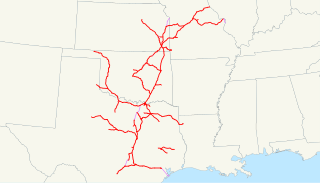
The Missouri–Kansas–Texas Railroad was a Class I railroad company in the United States, with its last headquarters in Dallas, Texas. Established in 1865 under the name Union Pacific Railroad (UP), Southern Branch, it came to serve an extensive rail network in Texas, Oklahoma, Kansas, and Missouri. In 1988, it merged with the Missouri Pacific Railroad; today, it is part of UP.

The St. Louis–San Francisco Railway, commonly known as the "Frisco", was a railroad that operated in the Midwest and South Central United States from 1876 to November 21, 1980. At the end of 1970, it operated 4,547 miles (7,318 km) of road on 6,574 miles (10,580 km) of track, not including subsidiaries Quanah, Acme and Pacific Railway and the Alabama, Tennessee and Northern Railroad; that year, it reported 12,795 million ton-miles of revenue freight and no passengers. In 1980 it was purchased by and absorbed into the Burlington Northern Railroad. Despite its name, it never came close to San Francisco.
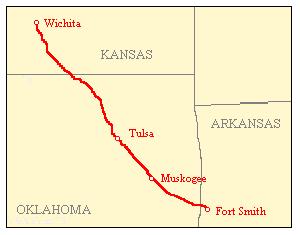
The Midland Valley Railroad (MV) was a railroad company incorporated on June 4, 1903 for the purpose of building a line from Hope, Arkansas, through Muskogee and Tulsa, Oklahoma to Wichita, Kansas. It was backed by C. Jared Ingersoll, a Philadelphia industrialist who owned coal mining properties in Indian Territory. The railroad took its name from Midland, Arkansas, a coal mining town in western Arkansas, which was served by the railroad. The Midland Valley gained access to Fort Smith, Arkansas via trackage rights over the Frisco from Rock Island, Oklahoma.
The Kansas, Oklahoma and Gulf Railway (“KO&G”) had at its height 310.5 miles of track from Denison, Texas through Oklahoma to Baxter Springs, Kansas. Its various predecessor companies built the line between 1904 and 1913. The railroad was consolidated into a Missouri Pacific Railroad subsidiary—the Texas and Pacific Railway—in 1963.
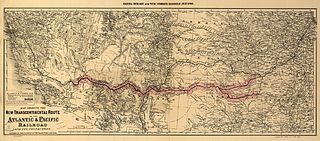
The Atlantic and Pacific Railroad was a U.S. railroad that owned or operated two disjointed segments, one connecting St. Louis, Missouri with Tulsa, Oklahoma, and the other connecting Albuquerque, New Mexico with Needles in Southern California. It was incorporated by the U.S. Congress in 1866 as a transcontinental railroad connecting Springfield, Missouri and Van Buren, Arkansas with California. The central portion was never constructed, and the two halves later became parts of the St. Louis-San Francisco Railway and Atchison, Topeka and Santa Fe Railway systems, now both merged into the BNSF Railway.
The Kansas City, Clinton and Springfield Railway ("KCC&SR"), also known as the Leaky Roof Railway, was a consolidation of earlier railroads. As of 1917, it had a mainline running from Ash Grove, Missouri through Clinton, Missouri to Olathe, Kansas, almost 155 miles. It has since been abandoned.
The Belton, Grandview and Kansas City Railroad (SHRX) is short line passenger railroad and museum located in Belton, Missouri. It operates as a heritage railroad, on what was once the St. Louis and San Francisco Railway (Frisco), on the Kansas City to Springfield branch. With the merger of the Frisco with the Burlington Northern, the line was partially sold to the Kansas City Southern Railway north of 155th Street. The north of the line is used once a year when tree trimming/weed spraying takes place, and the tracks are bad though can still can be used. The bridge is still there past Markey Road but with missing ties, while the southernmost portion from Peculiar, MO. to Clinton, MO. has been scrapped and abandoned. This left the remaining trackage of a few miles connecting Grandview and Belton, Missouri. The railroad currently operates a 1952 GM GP 9 locomotive, which is used to pull an excursion train. Also included in the railroad's collection are various locomotives, cars and equipment.
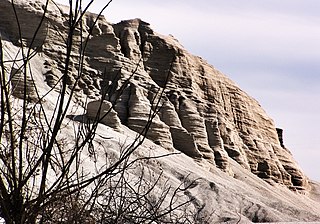
Tar Creek Superfund site is a United States Superfund site, declared in 1983, located in the cities of Picher, Douthat and Cardin, Ottawa County, in northeastern Oklahoma. From 1900 to the 1960s lead mining and zinc mining companies left behind huge open chat piles that were heavily contaminated by these metals, cadmium, and others. Metals from the mining waste leached into the soil, and seeped into groundwater, ponds, and lakes. Because of the contamination, Picher children have suffered elevated lead, zinc and manganese levels, resulting in learning disabilities and a variety of other health problems. The EPA declared Picher to be one of the most toxic areas in the United States.
The following is a brief history of the North American rail system, mainly through major changes to Class I railroads, the largest class by operating revenue.
Douthat is a ghost town in Ottawa County, Oklahoma, United States. Douthat is 2 miles (3.2 km) south of Picher. Douthat once had a post office, which opened on March 17, 1917. The community was named after Zahn A. Douthat, the owner of the townsite. Douthat is now abandoned and part of the Tar Creek Superfund site.
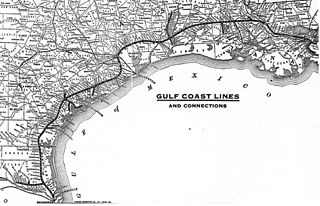
The Gulf Coast Lines was the name of a railroad system comprising three principal railroads, as well as some smaller ones, that stretched from New Orleans, Louisiana, via Baton Rouge and Houston to Brownsville, Texas. Originally chartered as subsidiaries of the Frisco Railroad, the system became independent in 1916 and was purchased by the Missouri Pacific Railroad in 1925.

The Kansas City–Florida Special was a pooled night train and the premier train of the Frisco Railroad and the Southern Railway. Operating from Kansas City, Missouri to Jacksonville, Florida, it was unique as being one of very few long distance passenger train to traverse the Mississippi River south of St. Louis, Missouri and north of New Orleans, Louisiana.

Hockerville is a ghost town in northern Ottawa County, Oklahoma, United States. Hockerville was a mining community near the Kansas-Oklahoma border; it once had more than 500 residents. At least 18 mines operated in the Hockerville area in 1918 alone.
The Okmulgee Northern Railway Company (ON), originally the Coalton Railway, was a shortline rail carrier in Okmulgee County, Oklahoma. It was in operation from 1916 to 1964.
The West Tulsa Belt Railway (WTB) was an odd railroad for multiple reasons. It had only about two miles of track, located in or about West Tulsa, Oklahoma. It had no mainline, instead consisting of just sidetracks and yards. And, it had no locomotives, rolling stock, or employees to operate it, instead being run from its inception by another railroad's equipment and personnel.
The Southwest Missouri Railroad Company was a rail carrier in the tri-state mining region of southwestern Missouri, southeastern Kansas and northeastern Oklahoma. An outgrowth of passenger streetcar lines with 94 miles of track, it became a smaller but full-fledged electric freight railway by the time it ceased operations effective May 31, 1939.
The predecessor rail lines which eventually came together as the Northeast Oklahoma Railroad (“NEO”) started as early as 1906, with some routes continuing until NEO was merged into the St. Louis-San Francisco Railroad (“Frisco”) in 1967. At its maximum, NEO ran approximately 34 miles of track in the area of the Tri-state mining district of southeast Kansas, northeast Oklahoma and southwest Missouri, although NEO itself only had operations in Kansas and Oklahoma.
The Kansas City, Fort Scott and Memphis Railroad (“KCFS&M”) was a railway system which, at its maximum extent, operated across Kansas, Missouri, Arkansas, Tennessee, Mississippi, Alabama and Oklahoma, a total of over 881 miles. Its predecessor company started in 1865, and another railroad assumed ownership in 1928.









